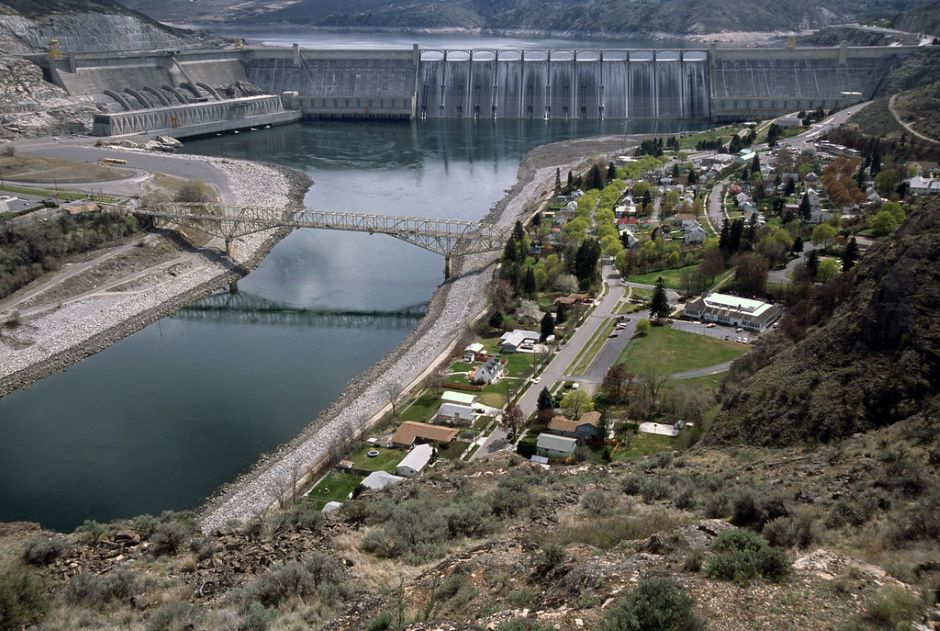Restoring Salmon above the Grand Coulee Dam
 Grand Coulee Dam, Washington, Okanogan Wenatchee National Forest (Credit: Forest Service Pacific Northwest Region, Public Domain)
Grand Coulee Dam, Washington, Okanogan Wenatchee National Forest (Credit: Forest Service Pacific Northwest Region, Public Domain)Prior to the construction of the Grand Coulee Dam in 1942, the Spokane Tribe thrived off of the river and the salmon that once ran up and down the river during their annual runs. However, when the dam was constructed, the team failed to install a fish latter or other methods for fish to pass the dam. According to the Upper Columbia United Tribes (UCUT), the dam also led to the creation of Lake Roosevelt, raising the waters of the Columbia and Spokane Rivers by approximately 70 feet. The UCUT shares, “Traditional fishing sites, burial grounds, and sacred cultural gathering places lay beneath Lake Roosevelt.”
The change in depth killed many of the species that resided on both sides of the damn and effectively trapped salmon in the freshwater Upper Columbia River. Considering salmon no longer had the ability to move toward the ocean, annual runs and population sizes were hurt. In addition to the damage done to the fish inhabiting the region, the Spokane Tribe lost one of their primary food sources.
In similar circumstances, the U.S. government has reimbursed indigenous groups when resources were taken, used or lost. Legally, under Order No. 3335, “The federal government is required to maintain a trust responsibility with tribes,” according to UCUT. In discussions with tribal leaders in regard to the dam and the damage it caused to surrounding areas, the federal government promised the Tribe reasonable compensation for their losses. However, when the time came, the Tribe was only paid $4,700.
The Tribe has not received further reimbursement, and the dam has continued to generate revenue using taken land. The Grand Coulee Dam has continued to accrue profit as a hydroelectric generator and as a water supply for nearby towns. The dam is also a tourist site that draws thousands of visitors and revenue every year. All of which has created wealth for everyone except for the Spokane.
UCUT reports that the Spokane have tried negotiating with the federal government for nearly a century, but to no avail. Every time the Spokane have tried to negotiate in D.C., another emergency arises elsewhere in the world. UCUT explains that in December 1941, tribal leaders went to D.C. seeking compensation, but three days before the meetings were scheduled, the attack on Pearl Harbor happened. The U.S. was then launched into World War II, and the Spokane were placed on the back-burner.
The Upper Columbia River Study
UCUT reports, “In 2015, the Columbia Basin Tribes and First Nations (CBTFN) finalized the Joint Paper ‘Fish Passage and Reintroduction into the U.S. and Canadian Upper Columbia Basin.'” The proposed plan is comprised of four parts. Phase 1was completed in 2019 and “consisted of a reintroduction risk and donor stock assessment, multiple assessments of habitat availability and suitability, an evaluation of fish passage technologies at high-head dams, Grand Coulee and Chief Joseph dams’ operations and configurations, and life cycle modeling.”
Phase 1 revealed something advocates for salmon restoration in the Upper Columbia have been saying for decades. “Grand Coulee Dam should have been built with fish passage,” said John Osborn, a Spokane Tribe member and salmon restoration advocate, in an interview with The Associated Press. UCUT projects Phase 2 as taking place over another several years with baseline studies and the construction of interim facilities (years 1-6) and constructing interim passages and conducting supporting studies (years 7-21).
UCUT emphasizes the following steps in step 2:
- “Upstream passage at CJD
- Downstream passage at GCD
- Upstream passage at GCD
- Upstream passage at Spokane River dams
- Downstream passage at CJD and Spokane River dams.”
Conclusion
In 2021, it appeared that Phase 2 was already beginning to work as salmon were once again seen spawning in the Upper Columbia again, reports KUOW. Throughout 2021 restoration teams walked the Upper Columbia beyond the Grand Coulee Dam and found over 50 salmon nests that will helpfully spawn a multitude of fish into the river. After spawning, adult salmon typically die due to a strenuous season and run. The late adult fish will become food and nutrients for the rest of the ecosystem. Bears, birds, and vegetation will consume nutrients from the adult salmon and prosper. Salmon are a keystone species because of the benefits they provide to their ecosystems.
Their disappearance in the 1940s harmed the Upper Columbia’s ecosystem health. However, as salmon make their return, the ecosystem may be restored alongside salmon populations. The Spokane and other Upper Columbian Tribes have also seen an important cultural restoration as salmon make their return. The Tribe relies on salmon for resources and an important link between stewardship and nature. John Osborn explains, “Justice and stewardship compel us to return salmon to these rivers.”



0 comments